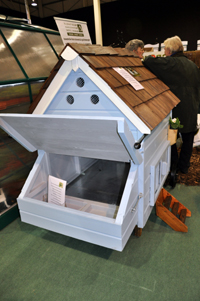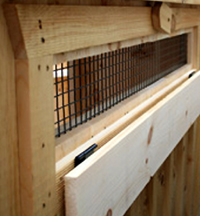Chicken houses or huts come in all shapes, sizes and qualities. The general principles are that it should be predator-proof, adequately ventilated, contain sufficient perches and nestboxes for the number of birds and have good access for cleaning. Wood is the commonest housing material, plastic makes for easier cleaning and fewer areas for mites to hide.

Space
Floor area should be a minimum of 30cm x 30cm per bird (large fowl) or 20cm x 20cm for bantams. If you can give them more space then so much the better bearing in mind they will be spending time in the henhouse sheltering from the rain and wind.
If a sliding or hinged roof is incorporated there is no need to have the house high enough for you to stand up in. It is useful to have a free-range house with a solid floor raised off the ground for about 20cm. This discourages rats and other vermin from hiding under the house and can make an extra shelter or dusting area for the birds. They are liable to lay under the house if their nestboxes are not adequate.
Ventilation
Correct ventilation is vital to prevent the build-up of bacteria, condensation and ammonia (from the droppings). It should be located near the roof to ensure there are no draughts and on two sides for good flow of air. It can be more difficult keeping the house cool than warm and in winter the ventilation should remain open.

Nestboxes
Should be located in the lowest, darkest part of the house as hens like to lay their eggs in secret places. Size for large fowl is 30cm x 30cm or 20cm x 20cm for bantams with one nest box per four hens. Larger pure breeds may need larger nestboxes.
Litter
Livestock woodshavings, commercial dust-extracted poultry litter or shredded paper makes the best litter in the nestbox and on the floor of the henhut. Straw can bring in bacteria, dust and mites so unless it is from a reputable source, best to avoid. Never use hay due to the danger of moulds affecting the hens.
Perches
Even for bantams, perches should be broad, 5cm across, with the top edges rounded. They should be the correct height for the breed so they can get on them easily and have room to stand up on them, but heavy breeds should have low perches to avoid feet bruising on descent. Perches should allow a minimum of 22cm for large fowl and 15cm for bantams. Allow 30cm between perches if more than one. Make sure they are higher than the nestboxes otherwise the hens will roost in them, dirtying them. Perching in birds is achieved when the bird crouches and tendons in the legs are passively tensed by the flexion of the joints, automatically clamping the digits around the perch.
Pophole
This is a low door wide enough so that the hens can go in and out of the house at will in daylight. The most practical design has a vertical sliding cover which is closed at night to prevent fox damage. The horizontal sliding popholes quickly get bunged up with muck and dirt and are difficult to close. Make sure the pophole is large enough for the larger breeds to get in and out.
Cleaning
How often the chicken house needs cleaning out will depend on the type of house, the number of chickens you have and the type of bedding material used. However, it is important to make sure that droppings and soiled bedding are removed and replaced regularly to prevent disease. Used chicken litter needs to be composted for a few months before being used as garden or allotment fertilizer as the high nitrogen content can burn plants if fresh used litter is spread on them.
Make sure that any disinfectant used is licensed for chickens or poultry to avoid toxicity. Examples are Virkon or F10. Most other poultry disinfectants are designed to be used on housing and equipment and allowed to dry before the hens are allowed back in.




